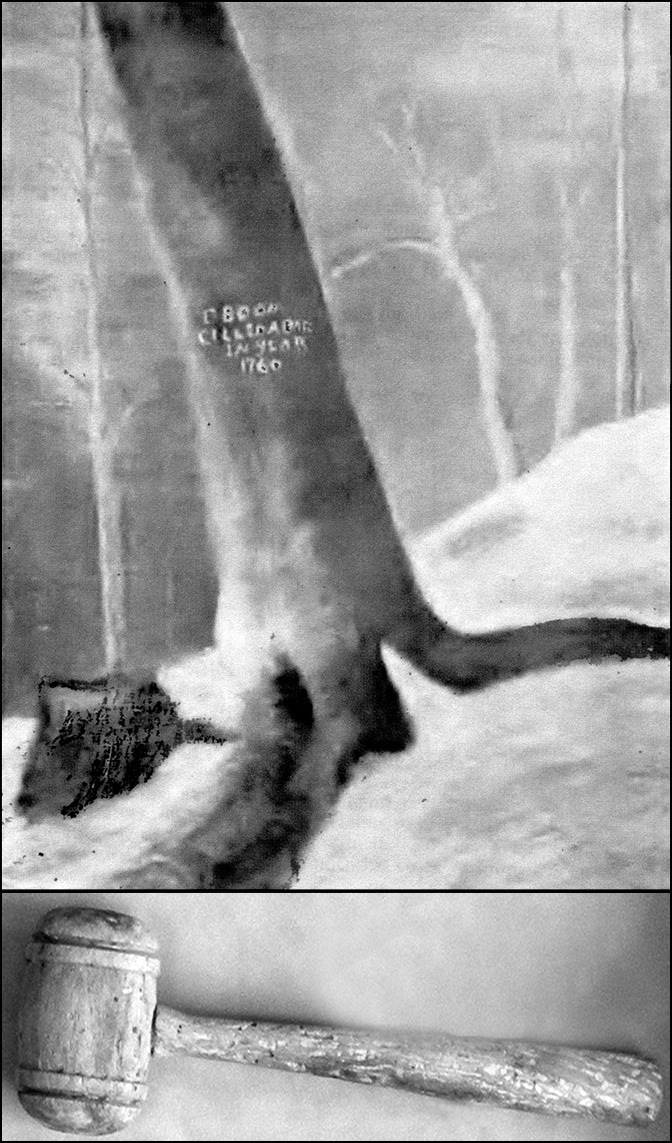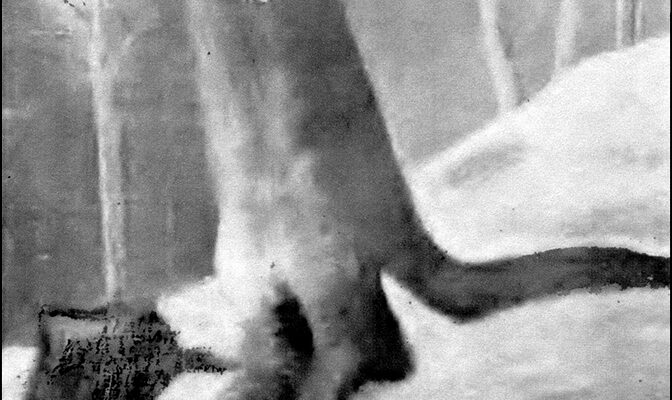Listed below are five Daniel Boone tree paraphrased news briefs taken from a variety of newspapers between 1874-97. The famous tree was popular with area history buffs throughout the years. It all started when the rugged pioneer paused at a beech tree in Boon's (Boones) Creek, likely rested his rifle against a tree and carved in it indelible characters documenting the highlight of his day's work: “D. Boon cilled a bar on the tree in year 1760.”

Painting of Daniel Boone Tree / One of the Gavels Taken from the Fallen Tree
Gavel Courtesy of Alan Bridwell
10-31-1874
The famous Boone tree, containing the earliest record of civilization in Tennessee, stood on the northwestern slope of a hill near the Blountville and Jonesboro stage road. The hill was thickly populated with beech, maple and oak trees. The land surrounding it was also ramified with gnarled roots, which covered the surface like an inextricable mat. The dense woods, the call of the little creek as it leaped in cascades over the tilted limestone and the deep gloominess of the forest provided wildness to the surrounding area.
At that point in time, the brave pioneer was 26 years of age and probable more than 100 miles from human habitation, relying upon his brave heart, strong arm and trusty rifle for existence. The tree was just two feet in diameter and leaned about three degrees (other sources suggest otherwise) from perpendicularity. It had been greatly defaced by visitors who inscribed their names for a distance of about 10 feet above the ground.
The large number of mounds with corresponding depressions that stretched from around the tree and several hundred yards to the southwest, were believed by some folks to have been an Indian mining camp. Others were convinced that they were the result of uprooted trees whose decaying roots left cherty (silica) beds high above the surrounding surface.
11-07-1879
The Tennessee Historical Society held a meeting in Nashville on that date. One agenda item was an 1800 display by W.S. Mathes of Jonesboro, containing a speech by General Jackson and two different views from S.W. Keen, also of Jonesboro. It dealt with the celebrated Daniel Boone tree on the waters of Boones Creek, which is about eight miles south of Jonesboro. A third Jonesboro resident, Prof. H. Presnell, was represented in one of the pictures. The tree was prominently mentioned in J.G.M Ramsey's noted book, The Annals of Tennessee.
01-09-1893
A large bear was spotted in Boones Creek near the Daniel Boone tree where the backwoodsman brought down a bear. When word traveled throughout the community, several sportsmen grabbed their hunting rifles and were anxious to locate and turn the usually omnivorous mammal into meat. It was believed that the deep snow in the mountains drove the bruin down in quest of a meal. The critter met with success when he feasted on chickens from the nearby farms of Jackson and Boyd. Many waited with eager anticipation when the animal would be taken down, permitting local residents to feast on bear steak for several weeks. No mention was made of the creature's demise.
04-21-1897
A worrisome report circulated the community that some nameless individual or group was making plans to cut the Boone tree down and send it to the Tennessee Centennial Exposition in Nashville. The statement created a great deal of talk spiced with a heavy dose of indignation for anyone guilty of attempting such a dastardly deed. After local resident, Captain Deaderick protested against the action, he received a telegram from Exposition officers stating that they had nothing to do with the rumor and would not accept the famed relic even if it were sent to them.
06-01-1897
The state agent of the Tennessee Centennial Exposition, recently went to Boones Creek to further investigate the threat of someone removing the tree. After examining the tree site, he firmly stated that this should not be done, expressing his belief that the tree was strong enough to stand a century longer by being still in a fair state of preservation, including the inscription cut in its bark by Daniel Boone almost a century and a half earlier.
Look for six additional Daniel Boone tree news items in a future heritage page feature story that includes the date the famed tree fell.
